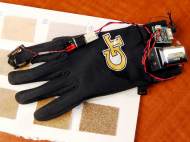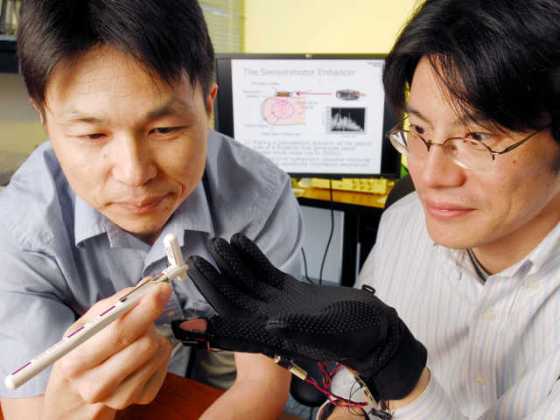A wearable device that vibrates fingertip could improve wearer’s touch
 Researchers at the Georgia Institute of Technology have developed a glove with a special fingertip which employs stochastic resonance in order to improve the wearer’s sense of touch and motor performance. The technology could be used to assist individuals whose jobs require high-precision manual dexterity or those with medical conditions that reduce their sense of touch.
Researchers at the Georgia Institute of Technology have developed a glove with a special fingertip which employs stochastic resonance in order to improve the wearer’s sense of touch and motor performance. The technology could be used to assist individuals whose jobs require high-precision manual dexterity or those with medical conditions that reduce their sense of touch.
Previous research has shown that the use of stochastic resonance can improve sight, hearing, balance control and touch, but the white noise had not been incorporated into a wearable device.
“All of the experimental results showed that some mechanical vibration was better than none at all, but the level of vibration that statistically improved sensorimotor functions varied by test”, said Jun Ueda, an assistant professor in the George W. Woodruff School of Mechanical Engineering at Georgia Tech.
Ueda worked with Minoru Shinohara, an associate professor in the School of Applied Physiology at Georgia Tech, and visiting scholar Yuichi Kurita, to design the device and test its capabilities on a small group of healthy individuals.
The device uses an actuator made of a stack of lead zirconate titanate layers to generate high-frequency vibration. The ceramic layers are piezoelectric, which means they vibrate when they experience an electrical charge. The actuator is attached to the side of the fingertip so that the palm-side of the finger remains free and the individual wearing the glove can continue to manipulate objects.
In order to test the device, the researchers attached the device to 10 healthy adult volunteers who performed common sensory and motor skill tasks, including texture discrimination, two-point discrimination, single-point touch and grasp tests. For each test, researchers attached the device to a volunteer’s non-dominant index finger and subjected the finger to six randomized vibrations that ranged from 0 to 150 percent of that person’s vibration amplitude threshold, a value that was determined by earlier testing where the subjects were asked when they can feel that the device was vibrating.
All four sensing ability tests confirmed that the application of certain levels of mechanical vibration enhanced the tactile sensitivity of the fingertip. However, because the levels of vibration that created statistically significant results varied, the researchers are currently conducting experiments to determine the optimal amplitude and frequency characteristics of vibration and the influence of long-term exposure to vibrations. The researchers are also working on optimizing the design of the glove and testing the effect of attaching actuators to both sides of the fingertip or the fingernail.
“The future of this research may lead to the development of a novel orthopedic device that can help people with peripheral nerve damage resume their daily activities or improve the abilities of individuals with jobs that require skills in manipulation or texture discrimination”, said Ueda.










Leave your response!